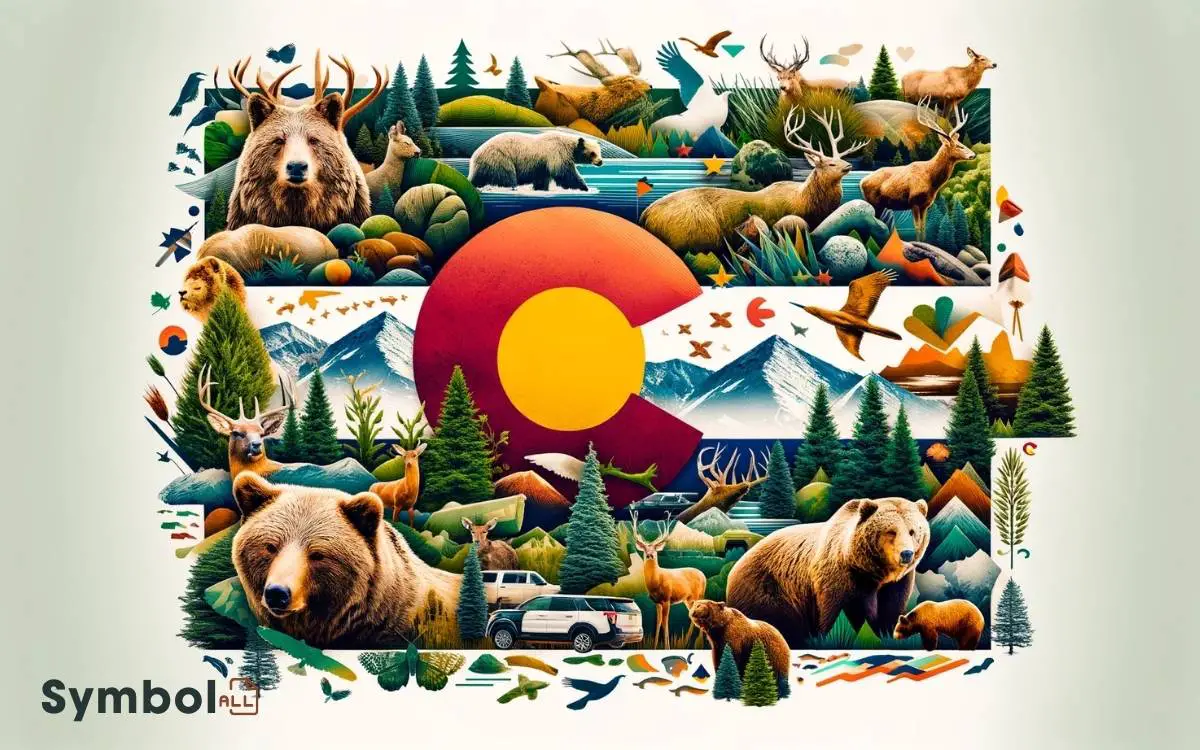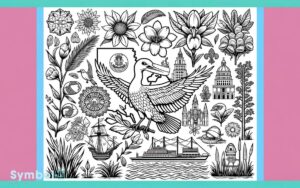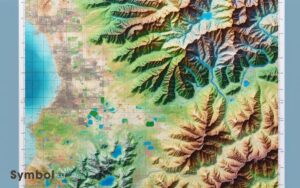List of Colorado State Symbols: Find Out Here!
You’ll find Colorado’s state symbols deeply tied to its natural beauty and historical significance. The state flag’s blue, gold, white, and red encapsulate the sky, gold mining history, snowy mountains, and the soil beneath your feet, while the seal reflects authority since 1877.
The Rocky Mountain Bighorn Sheep, your official state animal, exemplifies the state’s rugged terrain and resilience.
The Columbine and Blue Spruce, as the state flower and tree, shine a light on dedication to preserving natural heritage.
From the melodious Lark Bunting to the agile Greenback Cutthroat Trout, each symbol has a story that mirrors Colorado’s diverse ecosystems and conservation efforts.
Uncover deeper insights into these symbols and you’ll grasp a fuller picture of Colorado’s identity.

Key Takeaway
Official Colorado State Symbols List
| Symbol Type | Name | Adopted |
|---|---|---|
| State Animal | Rocky Mountain Bighorn Sheep | 1961 |
| State Bird | Lark Bunting | 1931 |
| State Fish | Greenback Cutthroat Trout | 1994 |
| State Flower | Rocky Mountain Columbine | 1899 |
| State Tree | Colorado Blue Spruce | 1939 |
| State Fossil | Stegosaurus | 1982 |
| State Mineral | Rhodochrosite | 2002 |
| State Gemstone | Aquamarine | 1971 |
| State Insect | Colorado Hairstreak Butterfly | 1996 |
| State Grass | Blue Grama Grass | 1987 |
| State Reptile | Western Painted Turtle | 2008 |
| State Song | “Where the Columbines Grow” | 1915 |
| State Folk Dance | Square Dance | 1992 |
| State Rock | Yule Marble | 2004 |
| State Tartan | Colorado State Tartan | 1997 |
| State Dinosaur | Stegosaurus | 1982 |
| State Cactus | Claret Cup Cactus | 2014 |
| State Pet | Shelter Pets | 2013 |
| State Grass | Blue Grama | 1987 |
| State Song | “Rocky Mountain High” by John Denver | 2007 |
State Flag and Seal
While the Colorado state flag symbolizes the state’s natural beauty and history, the state seal embodies its authority and governance, both serving as important identifiers and symbols of pride for residents.
You’ll find that the flag’s elements aren’t arbitrary; each color and symbol has been chosen with purpose.
The blue represents the skies, the gold acknowledges the state’s gold mining history, the white symbolizes the snow-capped mountains, and the red represents the soil.
In contrast, the state seal, adopted in 1877, encapsulates the state’s values and authority, featuring tools of mining, mountains, and the eye of providence – signifying Colorado’s resources and its underpinning ethos of perseverance and watchfulness.
Analyzing these symbols gives you a deeper appreciation of Colorado’s identity and the narratives it chooses to present. Analyzing these symbols gives you a deeper appreciation of Colorado’s identity and the narratives it chooses to present. These narratives often intertwine natural beauty with human ingenuity, showcasing a state that values both its rugged landscapes and progressive spirit. Just as the methodical use of inductive Bible study colors can bring clarity and deeper understanding to scripture, examining Colorado’s symbols through a similar lens highlights the layers of meaning that define its culture and heritage.
Official State Animal
You’ve learned about Colorado’s state flag and seal, but understanding its official state animal, the Rocky Mountain Bighorn Sheep, offers even deeper insights into the state’s identity and values.
This majestic animal isn’t just a symbol; it reflects Colorado’s rugged terrain and the resilience required to thrive in it.
Exploring its significance reveals how deeply intertwined the state’s natural history and cultural identity are.
Rocky Mountain Bighorn Sheep
The Rocky Mountain Bighorn Sheep, designated as Colorado’s official state animal, embodies the rugged beauty and spirit of the state’s high country landscapes.
When you picture these majestic creatures, several distinctive features come to mind:
- Their impressive, curled horns, which can weigh up to 30 pounds for males, symbolizing strength and resilience.
- Their sure-footed agility on steep, rocky terrains, demonstrating remarkable balance and grace.
- Their thick, double-layered coat, providing insulation against harsh winter conditions, showcasing adaptation and survival.
- Their keen eyesight, allowing them to spot predators from a distance, illustrating vigilance and awareness.
Analyzing their characteristics and behaviors offers insight into how the Rocky Mountain Bighorn Sheep thrives in its challenging environment, mirroring the fortitude and adaptability required to flourish amidst Colorado’s high altitudes and variable climates.
Symbols Significance Explained
Delving into the significance of the Rocky Mountain Bighorn Sheep as Colorado’s state animal uncovers a deep connection between the state’s identity and the attributes of this majestic creature.
Symbolizing resilience, the bighorn sheep thrives in the rugged mountainous terrains of Colorado, mirroring the state’s challenging landscapes and the spirit of its people who value perseverance.
Its impressive horns, growing throughout its life, signify strength and determination, qualities deeply embedded in Colorado’s culture.
Additionally, the sheep’s social structure, characterized by strong community bonds, reflects the unity and cooperation among Colorado residents.
State Bird and Fish
Exploring Colorado’s rich natural heritage, one can’t help but admire its state bird, the Lark Bunting, and the Greenback Cutthroat Trout, its official state fish, both emblematic of the state’s diverse ecosystems and conservation efforts.
These species not only reflect Colorado’s commitment to preserving its natural beauty but also highlight the importance of biodiversity.
- Lark Bunting: Spotted in the spring, its melodious song fills the air, a herald of warmer days.
- Greenback Cutthroat Trout: Thrives in the cold, clear waters of Colorado’s mountain streams, a survivor of efforts to save it from extinction.
- Habitat Conservation: Essential for these species, reflecting Colorado’s proactive stance on environmental preservation.
- Symbolic Representation: Each species embodies the resilience and beauty of Colorado’s natural landscapes, inspiring both residents and visitors.
These symbols serve as a constant reminder of the value of nature and the importance of conservation.
State Flower and Tree
Moving from the skies and streams to the soil and branches, Colorado’s state flower, the Columbine, and its state tree, the Blue Spruce, stand as affirmations to the state’s rich flora and commitment to environmental diversity.
The Columbine, with its delicate, bell-shaped flowers and vibrant colors, symbolizes not only the beauty of Colorado’s wild landscapes but also resilience and endurance. It thrives in both high altitudes and challenging climates, mirroring the state’s rugged terrain.
On the other hand, the Blue Spruce, towering and majestic, represents stability and strength. Its evergreen nature and impressive height contribute significantly to Colorado’s forest ecosystems, offering shelter and sustenance to wildlife.
Together, these symbols encapsulate Colorado’s dedication to preserving its natural heritage, reflecting the state’s ecological values and its inhabitants’ connection to the land.
State Insect and Reptile
You’ll find that Colorado’s state insect not only plays a pivotal role in the local ecosystem but also embodies the state’s natural beauty and biodiversity.
When examining the state’s unique reptile, its distinct features spotlight Colorado’s rich and varied wildlife habitat, a demonstration to the state’s commitment to preserving its natural heritage.
These conservation efforts underscore the importance of both the insect and reptile in maintaining ecological balance and fostering a deeper understanding of Colorado’s environmental priorities.
Colorado State Insect
Since its designation, the Colorado hairstreak butterfly has proudly served as the state insect of Colorado, symbolizing the state’s diverse and vibrant natural habitat.
This remarkable insect isn’t just a colorful spectacle; it plays an essential role in the ecosystem, highlighting the importance of biodiversity and conservation efforts within the state.
- Vivid purple wings: Reflecting the majestic beauty of Colorado’s landscapes.
- Distinctive orange spots: Mimicking the setting sun against the Rocky Mountains.
- Preference for oak shrubs: Indicating the butterfly’s unique habitat requirements.
- Lifecycle tied to native flora: Demonstrating the interconnectedness of Colorado’s ecosystems.
Understanding the significance of the Colorado hairstreak butterfly encourages a deeper appreciation for the state’s natural heritage and the need to protect its unique inhabitants.
Unique Reptile Features
Exploring the unique characteristics of Colorado’s state reptile offers insight into the state’s diverse ecological landscape, paralleling the distinct qualities of the Colorado hairstreak butterfly.
This reptile, adapted to Colorado’s varied climates, showcases a remarkable ability to thrive across different environments.
Its skin, unlike the delicate wings of the butterfly, is tough and scales are well-suited for minimizing water loss in arid regions, reflecting an evolutionary marvel.
Its coloration, much like the hairstreak’s vibrant hues, serves as camouflage, blending seamlessly with the natural surroundings to evade predators.
Moreover, its diet and hunting strategies are finely tuned to the state’s ecosystem, indicating a deep-rooted connection with the local flora and fauna.
This reptile’s unique features not only underline its resilience but also embody the ecological richness of Colorado.
Conservation Efforts
Efforts to safeguard Colorado’s state insect, the Colorado hairstreak butterfly, and its state reptile have ramped up in response to growing environmental challenges, highlighting the critical importance of conservation strategies in preserving these emblematic species.
As you explore further into these efforts, you’ll find:
- Habitat Restoration: Projects aimed at rejuvenating native flora to support the butterfly’s and reptile’s natural habitats.
- Public Education: Programs designed to increase awareness and foster a communal spirit of conservation.
- Research Initiatives: Scientific studies focusing on the life cycles, habitats, and threats to these species to inform conservation strategies.
- Legislative Protections: Laws and regulations enacted to protect these species from human encroachment and other threats.
These concerted efforts underscore a recognition of the intrinsic value these species add to Colorado’s biodiversity and the broader environmental health.
State Songs and Dance
Colorado boasts a rich tapestry of musical heritage, encapsulated in its official state songs and celebrated through its designated state dance, each embodying the state’s diverse cultural and geographical landscapes.
These symbols serve not just as mere representations of pride and tradition but also as critical tools for understanding the state’s identity and ethos.
The state songs, with their lyrical narratives and melodies, capture the essence of Colorado’s history, its natural beauty, and the pioneering spirit of its people.
Similarly, the state dance, with its specific movements and rhythms, offers a window into the social and cultural life of Colorado, reflecting the influences of various communities that have contributed to the state’s rich cultural fabric.
Geological and Fossil Symbols
Delving into the geological and fossil symbols provides a unique lens through which you can appreciate the intricate tapestry of Colorado’s natural history.
These symbols are more than mere indicators; they’re a reflection of the state’s deep-rooted geological and paleontological heritage.
Colorado’s selection of symbols in this category is a confirmation of its rich and varied past, offering insights into the environmental and climatic shifts over millions of years.
- Yule Marble: A confirmation of Colorado’s robust geology, quarried for its pristine quality and used in national monuments.
- Stegosaurus: Emblematic of Colorado’s rich fossil record, showcasing the state’s prehistoric landscapes.
- Rhodochrosite: Known as the ‘Alma gemstone,’ symbolizing the beauty and complexity of Colorado’s mineral wealth.
- Aquamarine: Reflecting the state’s high-altitude gemstone treasures, found in the Mount Antero area.
These symbols collectively narrate a story of geological evolution and prehistoric life, inviting a deeper understanding and appreciation of Colorado’s natural legacy.
Conclusion
In exploring Colorado’s state symbols, you’ve journeyed through a rich tapestry of nature and culture.
Intriguingly, the Lark Bunting, Colorado’s state bird, undergoes a dramatic transformation, with males shifting from a nondescript brown to a striking black and white during mating season—a powerful metaphor for the state’s dynamic beauty and diversity.
This adaptability underscores Colorado’s essence, weaving a narrative of resilience and change that’s as enthralling as the state itself. Each symbol offers a deeper insight into Colorado’s unique identity and heritage.






